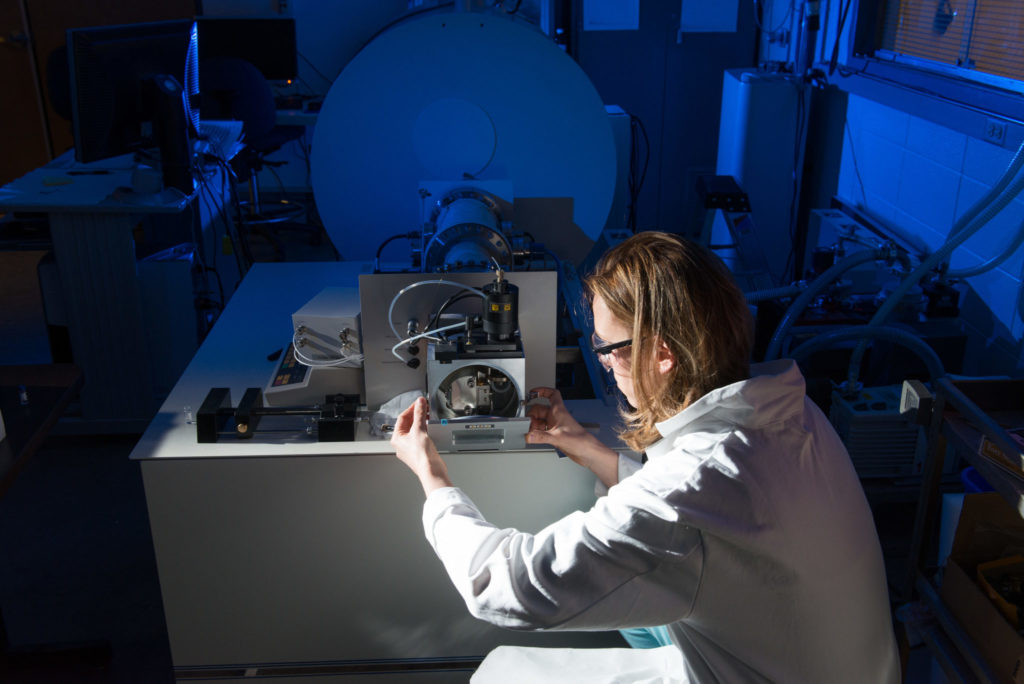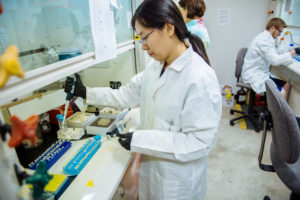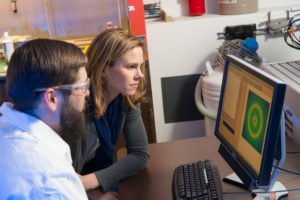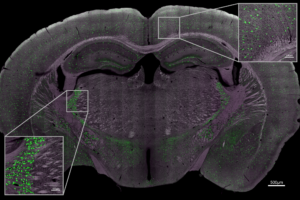
Director of ARC-MMA center, Karolien Denef, conducts research in lab.
Colorado State University has taken a major step to expand its research capabilities and opportunities for scientific collaboration with academic institutions and industry partners by combining three core facilities into a single streamlined analytical center.
On July 1, CSU’s Central Instrument Facility, the Microscope Imaging Network, and the Proteomics and Metabolomics Facility, merged to create the new Analytical Resources Core administered under the Office of the Vice President for Research
“As technological advances are rapidly evolving, no individual researcher or lab can master the technologies, nor afford the sophisticated instrumentation necessary to stay current, regardless of the field,” explained Assistant Vice President for Strategic Initiatives Ellen Fisher, who oversees the new ARC. “Thus, many of the latest headline-making breakthroughs would not be possible without high-end research support infrastructures such as core facilities.”
These three facilities have a long history at CSU. The Central Instrument Facility was originally founded and operated under the Department of Chemistry. The Microscope Imaging Network and the Proteomics and Metabolomics Facility were under the Department of Biochemistry and Molecular Biology. Both departments are under the College of Natural Sciences. Now working under one administrative unit, the ARC leadership team expects to see more collaboration across the University; efficiency with strategic planning; opportunities for new services and instruments; and stronger grant applications.
“Combining these three analytical instrumentation-based core facilities will provide the platform for CSU to reach the next level of research excellence, especially in these resource-limited times,” said Fisher.
Combined, the three facilities have contributed to training over 300 faculty and students in the 2019 fiscal year alone, with over 2,600 users accessing these facilities along with the Emerging Innovations Core facilities.
Areas of emerging technology

The Office of the Vice President for Research established the Core Research Facilities program in 2015 to ensure access to state-of-the-art research tools and expertise across the University, enabling development of new directions in emerging areas of research and technology. Each of the former facilities began by serving a specific aspect of research but had grown as technologies developed. Conversations about bringing them under a single administrative unit began around two years ago and involved core facility staff, stakeholders, investigators, colleges, and the OVPR.
“The Central Instrument Facility in the Department of Chemistry started out serving primarily, but not exclusively, the interests of chemistry,” said Chris Rithner, interim executive director of ARC and former director of the CIF. “Over the years, our scope expanded along with our mission. Meanwhile, the two other Foundational Cores have related analytical interests; we share core investigators in many cases, so we’ve come together in a new configuration, the ARC.”
Jan Nerger, dean of the College of Natural Sciences, applauded the new approach.
“This (creating the ARC) is what I would have done if I were starting from scratch to create a core facility at CSU,” she said.
Those who regularly use the now-combined facilities will see little change, instruments and staff will remain in their current buildings and processes will remain relatively familiar, as allowable with the new COVID-19 restrictions. The primary changes will be at the administrative level.
“The impacts from COVID-19 affect some deliverables for the ARC and may affect user fee pricing in the future,” Rithner said. “Every effort will be made to keep user fees as low as possible, and to not increase pricing beyond that which would occur in any given year.”
New names for expanded functions
The functions of the former facilities will operate in three new centers under the ARC: Bioanalysis and Omics, Materials and Molecular Analysis, and Image and Surface Science.
Bioanalysis and Omics
The BIO Center houses instruments and services formerly provided by the Proteomics and Metabolomics Facility. Although it has been renamed, the stockroom will remain unchanged as the new ARC-BIO stockroom.
Former PMF Director Corey Broeckling is the director of the BIO Center.
“Our services will remain, and hopefully continue to grow and improve,” Broeckling said about the change. “This process can help to accelerate that by exposing users to our services and by exposing our staff to new ideas and experimental tools.”
Broeckling is looking forward to interacting with a larger community of like-minded colleagues and improving services.
“This move is important,” Broeckling said. “This reorganization will help to facilitate knowledge transfer, administrative and scientific, between core facilities, which will ultimately result in better services.”
Materials and Molecular Analysis

The MMA Center focuses on spectroscopic, spectrometric and materials characterization services and instrumentation formerly within the Central Instrument Facility. Karolien Denef, former CIF associate director, is now the director for the MMA.
“Bringing the core facilities under one administrative unit will create huge efficiencies and streamline administrative oversight and support,” Denef said. “I believe the move will also create more visibility around all the amazing analytical resources CSU has to offer, which will undoubtedly strengthen CSU’s recruiting efforts.”
Operational duties in the Materials and Molecular Analysis Facility are being passed from Rithner to Claudia Boot.
Imaging and Surface Science
The ISS Center is merging instruments and services previously offered by both the Central Instrument Facility and the Microscope Imaging Network. This includes two electron microscopes and other surface science instrumentation. Jeff Field is the director of the ISS, after serving as director of the MIN.

“The commitment from the OVPR to back a merger like this plays very well on instrumentation grants,” Field said. “It shows we have a good structure for managing instruments and technical expertise and with the university support, we can really play at a higher level.”
Managing all the financial aspects of the ARC, including billing and iLab software, Andrea Morello now serves as the ARC’s business manager. Morello is also a resource for the directors, especially in the realm of business plans and other accounting expertise.
“Having this new position will allow the ARC staff to spend more of their time on maintaining instruments, training students, and contributing to the science being performed in the centers,” Fisher said.
CSU’s core facilities continue to be essential to the university. In fiscal year 2019 alone, core staff coauthored 76 peer-reviewed journal articles and four non-peer reviewed publications. Internal expense allocation in all core facilities has also increased from $4.8 million to $5.5 million in the last five fiscal years. Expenses are charged to over 500 unique accounts annually, representing the breadth of research activity that occurs in CSU’s core facilities.
“I am extremely excited as we embark on the next chapter in the story of core facilities at CSU, especially with the creation of this new, cohesive and collaborative Analytical Resources Core,” Fisher said. “Together, we will strive to create a highly visible, thriving core facility that supports and encourages cutting-edge innovation, discovery, and learning at CSU.”